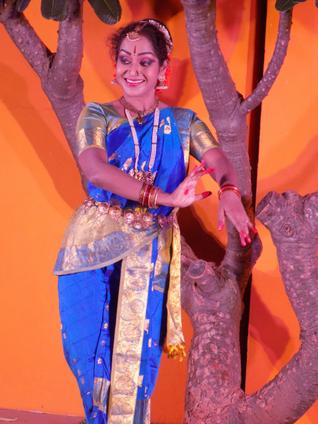
It was a pleasing recital by Yashoda Thakore who performed Kuchipudi after a long time.
Yashoda Thakore, who of late has been into the research and practice of Vilasini Natyam, has come back to perform Kuchipudi at Saptaparni’s amphitheatre recently. The repertoire she prepared for this event had some interesting numbers like Thyagaraja kirtana Maa Janaki Chetabattaga and giving a taste of one or two slokas from Nritta Ratnavali, of 12th century Jayapasena on which she worked for a book. She opened the recital dancing to the first sloka of ‘Nritta Ratnavali’ which was more a salutation to Siva. Dancing to a sloka is by itself is an art and the abhinaya she presented was apt in elevating the impact of sloka’s gist. In this she was also accompanied by three of her disciples to give a finishing touch.
Yashoda then chose to present a monumental piece of Thyagaraja and the only one he wrote keeping Sita in the forefront –Maa Janaki Chettabattaga, in Kambhoji. The kirtana’s significance is that Tyagaraja elevating Sita even beyond the image of Rama, saying that it was because he married Sita, he could achieve what all he achieved in his life including annihilation of Ravana. But for Sita, Rama would not have achieved this glory. The very pallavi says Maa Janaki Chettabattaga Maharajuvaitivi. In fact every charanam has such in-depth meaning that is a challenge for any dancer to interpret it aptly. Yashoda carefully etched the bhava in apt mudras and movements. The jatis she presented right after completing the pallavi line spoke of her command on nrutta. There were other places where she presented footwork without repeating herselfwhat she presented already. There were flute interludes too, more because the composition was tuned by a flautist.
The third number was Swara Pallavi in Arabhi. It is self explanatory for the pallavi was made up of swaras in that raga that repeat. It was more a footwork. Some jatis were long mirroring Yasoda’s time sense in presenting them for apt tala. The composition started with swaram as pallavi that was repeated all along in that raga. There was long jati too following pallavi.
A kirtana that figured later was Nadamurali Gana Vilola of Oothukadu Venkata Kavi tuned in Mohana in Tisragati. Here again as pallavi suggests it was Krishna’s flute play. There was a sloka taken out of Krishna Leela Tarangini.
The essence of the theme was to say that the entire nature was reacting to Krishna’s Murali Nadam. This was followed by the display of footwork on a plate and percussion jatis.
The final number was a Javali – Era Rara Marubariki Talagalera in Khamas an erotic number of Samanya Nayika who finally takes the name of Lord Venkateswara as her lover.
There was long Jati here too in the end before she closed her show. This was of Dharmapuri Subbarayasastry composition. Her students Alekhya Prabha, Asawari Bhagawat, Darshini, Sirichandana and Madhura took part with her guru in a couple of numbers.
source: http://www.thehindu.com / The Hindu / Home> Features> Friday Review / Gudipoodi Srihari / Hyderabad – July 07th, 2016